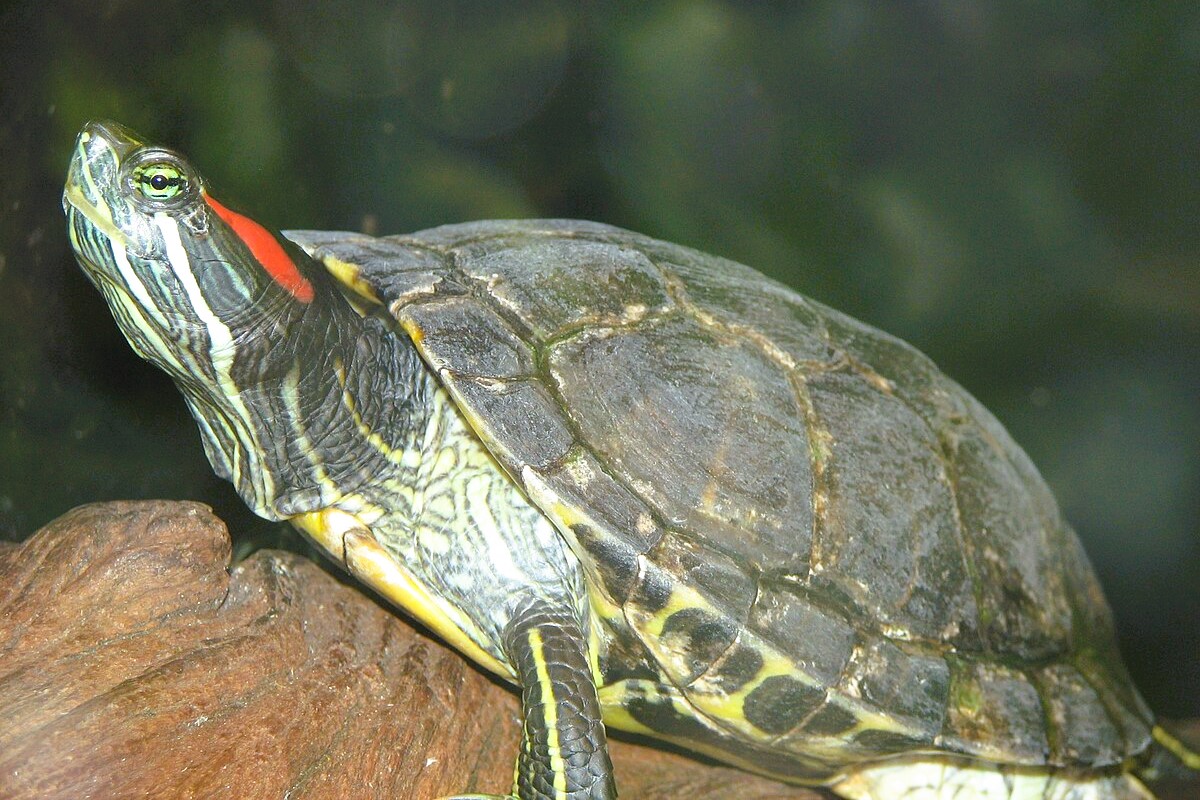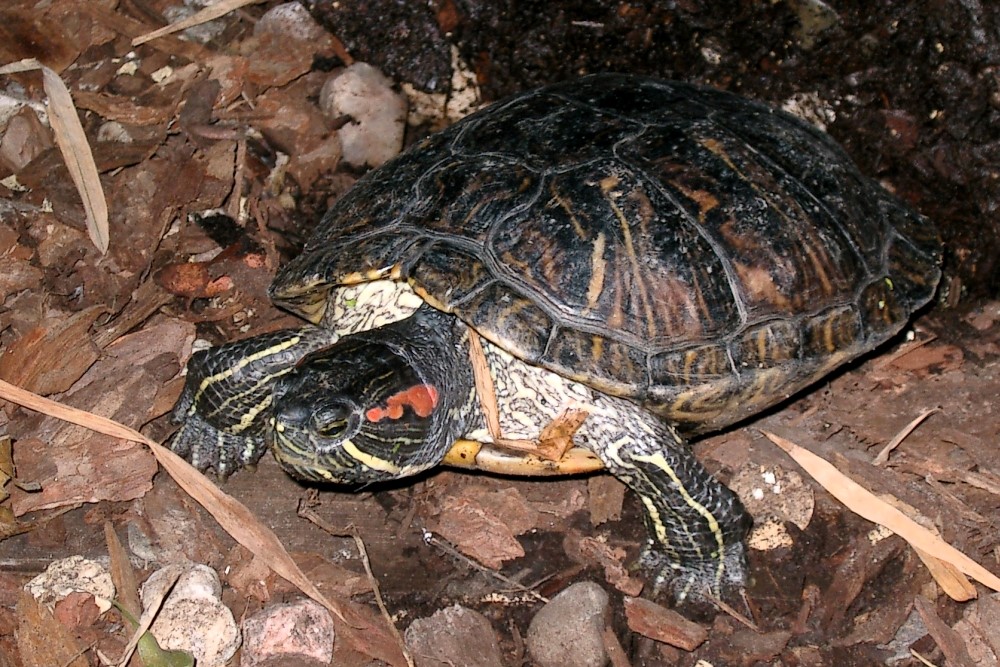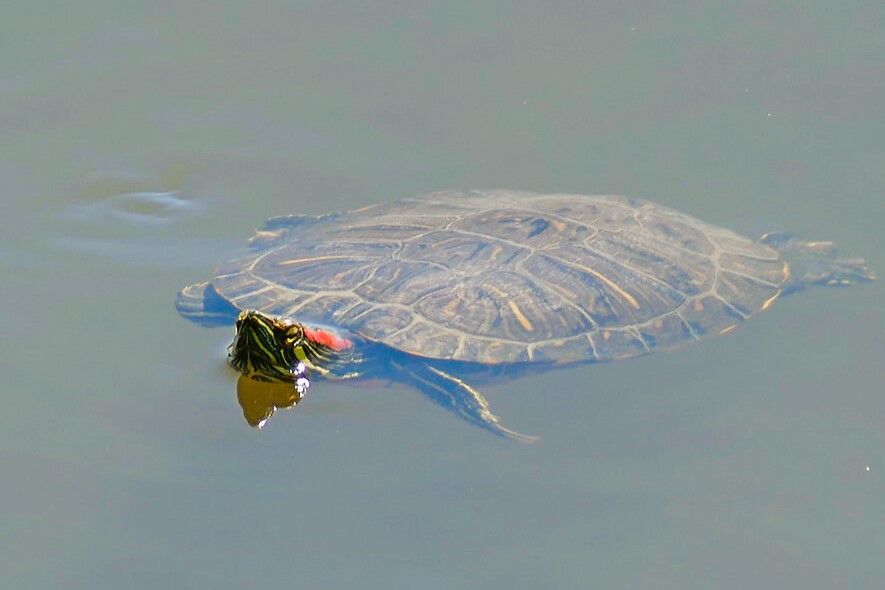Trachemys scripta elegans







Reptilia → Testudines → Cryptodira → Testudinoidea → Emydidae → Trachemys → Trachemys scripta → Trachemys scripta elegans
Testügin russa
The red-eared slider ( Trachemys scripta elegans ) is a medium-sized freshwater turtle, easily recognizable by the presence of a vivid red spot just behind each eye, which is a distinctive feature of the species. The carapace is oval-shaped and olive green with thin yellow stripes in juveniles, tending to darker tones and some wear of the original pattern with age. The plastron is yellow with distinct dark spots in variable arrangement. The species shows clear sexual dimorphism: females reach larger sizes, up to 12 in (30 cm) carapace length, while males rarely exceed 10 in (25 cm). The females can weigh up to 3.3–4.4 lbs (1,500–2,000 g), while males range between 2.2–2.6 lbs (1,000–1,200 g). Mature males can be distinguished by a long and thick tail, very developed front claws, and a slightly concave plastron; females, on the other hand, have a higher carapace, a flat plastron, and are generally larger.
Trachemys scripta elegans , native to the south-central United States, is now widely distributed as a non-native species in Europe, including western Liguria. Its presence in the province of Savona is exclusively linked to deliberate or accidental releases by private citizens into urban ponds, artificial basins, and slow-flowing river sections. The species has shown remarkable adaptability, colonizing various coastal and inland aquatic environments, where it often competes with native species such as Emys orbicularis .
This turtle prefers calm and well-lit waters such as ponds, canals, small lakes, slow-flowing streams, and artificial wetlands. The ideal habitat is characterized by abundant aquatic and riparian vegetation, muddy bottoms, and the presence of logs or emerging stones used as basking sites, which are essential for thermoregulation. It also frequently colonizes urban ponds and basins in public parks. The species' stable presence depends on the availability of suitable nesting areas and sunny spots for basking.
It is a diurnal species with predominantly aquatic habits. In western Liguria, it is often seen basking for long periods on logs and riverbanks, alternating between resting phases and sudden protective dives. An excellent swimmer, the red-eared slider spends the cold season dormant at the bottom of water bodies. Reproduction occurs in spring, with mating preceding egg-laying (between May and July): 5–20 eggs per nest are buried at a depth of 4–6 in (10–15 cm). Incubation generally lasts 60–80 days, with synchronized hatching at temperatures above 77 °F (25 °C). Hatchlings measure 1–1.4 in (2.5–3.5 cm) in length and weigh about 0.25–0.35 oz (7–10 g). This species is long-lived (up to 40 years or more in captivity).
Trachemys scripta elegans shows a very flexible and opportunistic diet that varies with age. Juveniles are distinctly carnivorous, feeding on aquatic insects, larvae, small fish, crustaceans, and mollusks. As adults, their diet expands to include a significant proportion of plant material, such as aquatic plants, algae, and plant remains, while not neglecting live prey like fish, aquatic invertebrates, and occasionally small amphibians. This dietary adaptation contributes to its negative impact on local ecosystems.
The expansion of the red-eared slider represents a serious threat to native aquatic biodiversity, mainly due to:
These impacts are compounded by the ongoing risk of new individuals being abandoned, making any containment attempt very difficult.
Trachemys scripta elegans is among the longest-lived and most adaptable turtles introduced, accidentally or intentionally, into Italian aquatic systems. Considered one of the world's 100 worst invasive species, it stands out for:
In western Liguria, monitoring and containment programs are active, including the active removal of individuals and a trade ban. Since 1997, the import of this species has been prohibited in the European Union, and individuals found in the wild must be removed to prevent further expansion. It is very important to inform the public not to release individuals into the wild and to promptly report any sightings to the competent authorities.